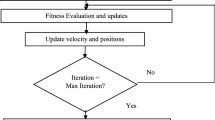Abstract
The data dissemination toward the sink node in a wireless sensor network in one of three ways: single-hop data dissemination, multi-hop dissemination, and multi-hop dissemination, using the nearest cluster head or sector head (SH). This study focuses on third multi-hop data dissemination in which SHs are selected in the network, other nodes disseminate data toward these SHs, and then, the SHs transfer the collected data to the sink node. This paper proposes a novel approach to SH selection called Energy-Efficient Reliable Sectoring-Scheme (EERSS). It is supported by an optimization algorithm called Cat Swarm Optimization (CSO), which proves that the elected number of SH is optimal. This CSO based EERSS algorithm is implemented to rank quality of service parameters, such as network lifetime maximization, with reliability and to minimize energy consumption. A path reliability prediction-based Markov chain model is applied to the CSO-based-EERSS algorithm to achieve results that are superior to that of traditional models. After the construction of the proposed prediction algorithms CSO-based-EERSS (P-CSO-EERSS), its performance is compared with that of the traditional CSO-based-EERSS, EERSS, and Particle Swarm Optimization based EERSS, concerning packet delivery ratio(PDR), end-to-end delay, and energy consumption. The SH selection performance of the proposed P-CSO-EERSS is superior to that of the traditional algorithms based on low energy consumption and high PDR.











Similar content being viewed by others
Data Availability
Attached separately.
References
Cheng, H., Xie, Z., Wu, L., Yu, Z., & Li, R. (2019). Data prediction model in wireless sensor networks based on bidirectional LSTM. EURASIP Journal on Wireless Communications and Networking, 2019, 1–12.
Huang, W., Song, T., Yang, Y., & Zhang, Y. (2019). Cluster-based cooperative caching with mobility prediction in vehicular named data networking. IEEE Access, 7, 23442–23458.
Sun, S., Zhao, J., Feng, X., Zhang, J., & Luo, J. (2019). Mobile multi-sink nodes path planning algorithm concerned with energy balance in wireless sensor networks. IEEE Access, 7, 96942–96952.
Al-Baz, A., & Al-Sayed, A. (2018). A new algorithm for cluster head selection in LEACH protocol in wireless sensor networks. International Journal of Communication Systems, 30(1), 1–13.
Sahnoun, A., El Abbadi, J., & Habbani, A. (2016). Path reliability metric for proactive MANET routing. In 2016 5th International conference on multimedia computing and systems (ICMCS), Marrakech, pp. 726–730.
Senouci, S., & Pujolle, G. (2004). Energy efficient routing in wireless ad hoc networks. IEEE International Conference on Communications, Paris, France, 7, 4057–4061.
Al-Shalabi, M., Anbar, M., Wan, T. C., & Khasawneh, A. (2018). Variants of the low-energy adaptive clustering hierarchy protocol: Survey, issues and challenges. Electronics, 7(8), 136.
Singh, S. K., Kumar, P., & Singh, J. P. (2017). A survey on successors of LEACH protocol. IEEE Access, 5, 4298–4328.
Dehghani, S., Barekatain, B., & Pourzaferani, M. (2018). An enhanced energy-aware cluster-based routing algorithm in wireless sensor networks. Wireless Personal Communications, 98(1), 1605–1635.
Al-Sodairi, S., & Ouni, R. (2018). Reliable and energy-efficient multi-hop LEACH-based clustering protocol for wireless sensor networks. Sustainable Computing: Informatics and Systems, 20, 1–13.
Wang, C., Zhang, Y., Wang, X., & Zhang, Z. (2018). Hybrid multihop partition-based clustering routing protocol for WSNs. IEEE Sensors Letters, 2, 1–4.
Banimelhem, O., & Khasawneh, S. (2012). GMCAR: Grid-based multipath with congestion avoidance routing protocol in wireless sensor networks. Ad Hoc Networks, 10(7), 1346–1361.
Naveen, J., Alphonse, P. J. A., & Chinnasamy, S. (2019). Track-sector-tree clustering scheme for dense wireless sensor networks. Cluster Computing, 22, 12421–12428.
Velmani, R., & Kaarthick, B. (2015). An efficient cluster-tree based data collection scheme for large mobile wireless sensor networks. IEEE Sensors Journal, 15(4), 2377–2390.
Yu, Y., Xue, B., Chen, Z., et al. (2019). Cluster tree topology construction method based on PSO algorithm to prolong the lifetime of ZigBee wireless sensor networks. Search Results Web results Journal of Wireless Networking and Communications, 2019, 199.
Gherbi, C., Aliouat, Z., & Benmohammed, M. (2017). A survey on clustering routing Protocols in wireless sensor networks. Sensing Reviews, 37(1), 12–25.
Divya, P., & Shivkumar, S. (2016). Comparison of GSTEB, HEED and PEGASIS protocols. In Proceedings international conference on. wireless communications signal processing and networking (WiSPNET), Chennai, India, pp. 1935–1939.
Sambo, D. W., Yenke, B. O., Förster, A., & Dayang, P. (2019). Optimized clustering algorithms for large wireless sensor networks: A review. Sensors, 19(2), 322.
Bahrami, M., Bozorg-Haddad, O., & Chu, X. (2018). Cat swarm optimization algorithm. In Studies in computational intelligence, pp. 9–18.
Wang, T., He, X., Zhou, M., et al. (2017). Link prediction in evolving networks based on popularity of nodes. Scientific Reports, 7, 7147.
Manickavelu, D., & Uthariaraj, V. (2014). Particle swarm optimization (PSO)-based node and link lifetime prediction algorithm for route recovery in MANET. EURASIP Journal on Wireless Communications and Networking., 2014, 1–10.
Singh, A., & Singh, T. (2019). End to end delay using Aodv-Artificial Neural Networks (Ann) to improve performance of Manets. International Journal of Recent Technology and Engineering (IJRTE), 8, 1.
Calarany, C., & Manoharan, R. (2018). Path stability prediction for stable routing using Markov chain model in MANETs, Vol. 7, No. 4.
Author information
Authors and Affiliations
Corresponding author
Ethics declarations
Conflict of interest
The authors declare that they have no conflict of interest.
Additional information
Publisher's Note
Springer Nature remains neutral with regard to jurisdictional claims in published maps and institutional affiliations.
Rights and permissions
About this article
Cite this article
Wategaonkar, D.N., Nagaraj, S.V. & Reshmi, T.R. Multi-hop Energy-Efficient Reliable Cluster-based Sectoring Scheme Using Markov Chain Model to Improve QoS Parameters in a WSN. Wireless Pers Commun 119, 393–421 (2021). https://doi.org/10.1007/s11277-021-08217-5
Accepted:
Published:
Issue Date:
DOI: https://doi.org/10.1007/s11277-021-08217-5




